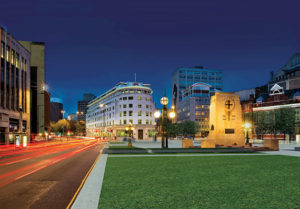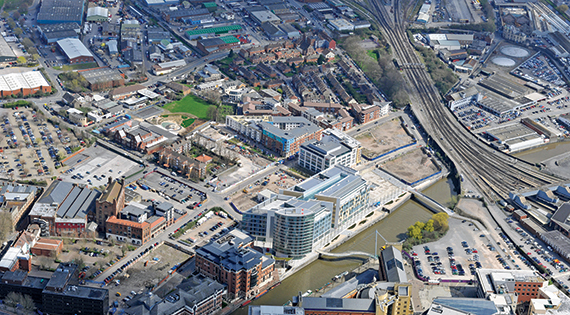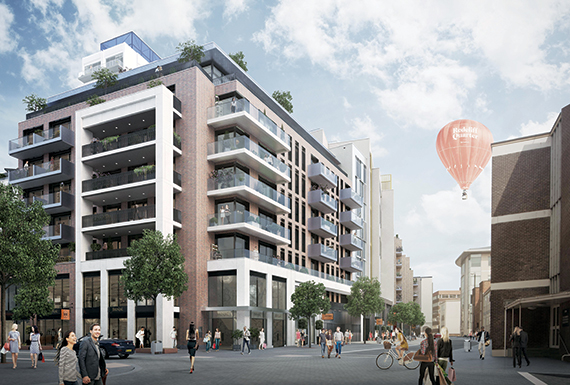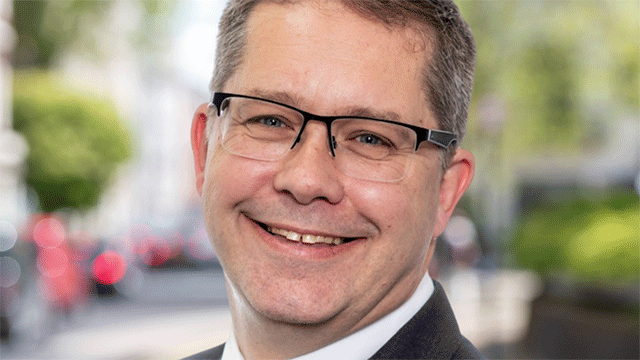Residential development and a high street revival means Bristol’s shopping and dining scene is growing up. Now all that’s left is for developers to connect the office and retail dots… Neil Tague reports
 Bristol’s Broadmead has become a shopping destination for property investors. It is a sign of turnaround for a retail street that saw footfall pulled to its eastern end by the arrival of the sleek, modern Cabot Circus, which opened in 2008.
Bristol’s Broadmead has become a shopping destination for property investors. It is a sign of turnaround for a retail street that saw footfall pulled to its eastern end by the arrival of the sleek, modern Cabot Circus, which opened in 2008.
The western end of what was originally Bristol’s prime retail pitch was almost considered obsolete but investment activity suggests otherwise, and it isn’t the only opportunity investors and developers are eyeing up in the city centre.
Union Gate (home to Cotswold Outdoors and others) has been the largest block to be sold, with Hunter Real Estate paying Praxis £9.6m with a yield of just over 7%. Sunnyday Capital bought 90-98 Broadmead for £5.7m (10.8%) with only 18 months left on Tesco Metro’s lease, while Sainsbury’s Local’s unit at 86-88 Union Street was sold for a 6.2% yield. The SWX nightclub and ground floor retail units on Nelson Street have also been bought by a private investor.
Gemma-Jane Ogden, investment surveyor at Hartnell Taylor Cook, says: “In 18 months, HTC alone has acted on £14m of retail transactions in the western half of Broadmead. We’ve recently acquired a unit with a five-year income, at 7.2%. Two years ago, this would have been a very different story – there were a large number of vacancies and many shops were significantly over-rented.”
Ogden attributes this mini-boom to two factors. First is residential development, much through the conversion of old office stock under Permitted Development Rights. The residential ranges from student accommodation to high-end professional pads, such as Crest Nicholson’s Electricity House.
The second factor is further development along Broadmead by Hammerson which, together with AXA, owns Cabot Circus. The developer is planning a multi-million pound regeneration with a mix of high street and independent retail and a substantial dining and leisure offer. A planning application is expected before the end of 2016 with an anticipated completion by 2020.
Peter Cooper, retail portfolio director at Hammerson, says: “Restaurant clusters work well in a central business district. They’re busy with office workers and shoppers in the week and people gravitate there at weekends. You can offer something for everyone. This could be a massively important connector in the Bristol city centre circuit.”
That is a key point. Heat maps of pedestrian activity highlight a massively underused stretch along The Horsefair between Debenhams and Cabot Circus, where the units are older and the streetscape bus-heavy.
Coherence is a big issue for Bristol – it’s a tough place for newcomers to navigate. Improving the key routes into the centre from Temple Meads station, so joining up the areas of development, is a top priority, and as investors have spotted an opportunity at the western end of Broadmead, developers have spotted opportunities elsewhere too, particularly for office development where headline rents are expected to rise from £28.50 to £30 per sq ft by the end of the year, according to Knight Frank..
One key player is Goodman, which in 2015 paid £24m for the 130,000 sq ft St Mary Le Port portfolio, which includes the Prudential Buildings, Bank House (let to Lloyds) and the mostly disused, forbidding-looking Bank of England building. The site has long been earmarked for redevelopment and a scheme there could have an end value in the region of £70m. It is also a key site overlooking Castle Park and Bristol Bridge, which is one of the main routes from Temple Meads station to the Broadmead shopping area.
A new footbridge linking Castle Park to Finzels Reach – the former Courage Brewery site – will be in place by Christmas. Cubex, developer of Finzels Reach, is speculatively building 95,000 sq ft of offices, the scheme’s second office building. A Premier Inn will open this year. In May, planning was secured for a further 194 apartments.
Cubex director Gavin Bridge says: “The bridge will improve connectivity, and ultimately we want to see Castle Park as heavily patronised as Queen Square.
“Hopefully people will start to use the city differently. You don’t see many suits in Cabot Circus at lunchtimes – we’ll do what we can to change things.”
For Peter Musgrove, office head at Lambert Smith Hampton, upping the quality of Victoria Street – the main pedestrian route into the core from Temple Meads – is the key.
He says: “With buildings like Paragon and Bridgewater House, there’s been a lot of new corporate space, but it’s not been matched by the amenities. There needs to be a focus on quality at ground floor level if we’re to promote ourselves as an international business city.”
The scheme that could make a difference here is Redcliff Quarter, where Change Real Estate has cleared a 2.5-acre site between Victoria Street and Redcliffe Way. In two phases, Change plans to bring 300 apartments, a 186-bedroom Radisson Red hotel and 20,000 sq ft of offices. The key lifestyle element is a restaurant cluster and a 25,000 sq ft food court, curated by local star chef Josh Eggleton and modelled on the Mercado da Ribeira in Lisbon.
Ron Persaud, Change director, says: “We’re doing a lot to lift the area – we’re improving the public realm on all three open sides of the scheme, making pavements wider and improving hard and soft landscaping.” The scheme is due to complete by 2020.
Such developments, it is hoped, will help improve pedestrian routes and attract valuable footfall through the city centre. Colliers International director Chris Dawson says: “The dots are being joined up, and the juxtaposition of property types in what is a relatively small CBD will lead to undeveloped sites coming forward. Quality will improve because the city will be more 24/7.”
 Up next
Up next
Beyond the likes of Finzels Reach, what might the next wave of development bring for Bristol? The former Avon fire station site across the road from Finzels is attracting heavy interest from developers with mixed-use in mind, while two office schemes in the pipeline on either side of Temple Way are AXA’s 240,000 sq ft business campus Assembly and RLAM’s Glassworks, where the 36,000 sq ft first phase won planning in March.
Bouygues’ development arm Linkcity has a key site behind the Glass Wharf scheme at Temple Quay, where it could spec-build a 90,000 sq ft-plus office block. More needs to happen around here: Temple Quay is, in the words of JLL office head Jeremy Richards, “a corporate success but not yet a community”. There is talk of a disconnect between the economic aspirations of Bristol and its masterplanning.
Colin Danks, planning director at Origin3, says: “Bristol needs to start a ripple effect of development out from Temple Quay to join with the projects towards Cabot Circus, and it will need people like Bouygues to invest.”
 Heightened ambitions
Heightened ambitions
For Jo Davis, regional senior director at Bilfinger GVA, it’s time for Bristol to grow up – literally. The city has been more resistant than other core cities to going tall with residential development, but to attain its growth goals, that has to change.
She says: “In policy terms, Bristol needs to be bold. As a city, it needs more density, height and scale. The existing tall buildings policy from 2005 is no longer adequate when you look at how UK cities have developed since. We need to have serious conversations about where we want to see height.”
Only by setting a standard, she says, will Bristol be able to ensure quality in future years.
The central tower at Redcliff Quarter is planned at 18 storeys – by no means monstrous – and Bristol Civic Society is among those with an issue.
Change Real Estate director Ron Persaud says: “Bristol needs more height to highlight its confidence as a city, and we believe this is a quality design.”











